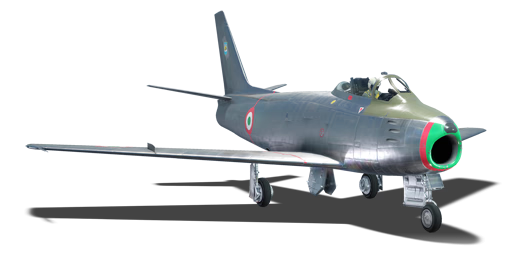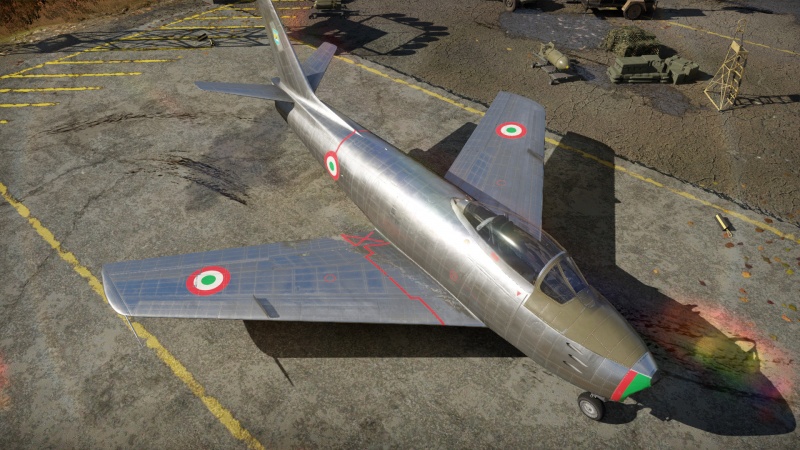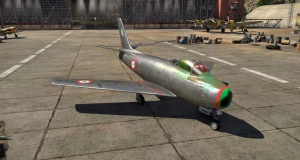Difference between revisions of "CL-13 Mk.4"
(→Pros and cons) (Tag: Visual edit) |
(Updated description to new format) |
||
| Line 12: | Line 12: | ||
== Description == | == Description == | ||
<!-- ''In the description, the first part should be about the history of and the creation and combat usage of the aircraft, as well as its key features. In the second part, tell the reader about the aircraft in the game. Insert a screenshot of the vehicle, so that if the novice player does not remember the vehicle by name, he will immediately understand what kind of vehicle the article is talking about.'' --> | <!-- ''In the description, the first part should be about the history of and the creation and combat usage of the aircraft, as well as its key features. In the second part, tell the reader about the aircraft in the game. Insert a screenshot of the vehicle, so that if the novice player does not remember the vehicle by name, he will immediately understand what kind of vehicle the article is talking about.'' --> | ||
| − | + | In 1949, Canada wanted a new fighter to supplement its growing air force. The F-86 Sabre was a good option, but the Canadian government didn't want to have another American aircraft in service. As a compromise, Canada received a license to build their own Sabres and thus birthed the Canadair Sabre. The Mk.4 was originally intended to have Canada's own engine in place of the J47-GE-13; the Avro Canada Orenda 10. It would've been a substantial improvement over the J47 but it wasn't ready by the time the Mk.4 was introduced and as such, the J47 was kept in. Other than minor changes like the compass, it was largely the same as the Canadair Sabre Mk.2. Italy would end up receiving over 170 Mk.4 Sabres from the Royal Air Force and continued to use them until the F-104 Starfighter began service with the Italian Air force. | |
| − | |||
| − | |||
| − | |||
| − | |||
| + | Introduced in [[Update 1.91 "Night Vision"]], the '''{{Specs|name}}''' is quite similar to the [[F-86A-5]]. It has roughly the same acceleration and has identical armament. However, it does have an all-flying tail which does help with manoeuvrability. The J47-GE-13 engine does not allow it to climb or accelerate as quickly as most of its opponents and the machine gun armament can be lacking against jet aircraft. Players should expect many critical hits when using the guns. Overall, the '''{{Specs|name}}''' is a decent aircraft although it has some deficiencies like the lack of significant engine power and subpar [[M3 Browning (12.7 mm)|M3 Browning machine guns]]. | ||
== General info == | == General info == | ||
=== Flight performance === | === Flight performance === | ||
Latest revision as of 04:52, 16 October 2023
| This page is about the Italian jet fighter CL-13 Mk.4. For other versions, see F-86 (Family). |
Contents
Description
In 1949, Canada wanted a new fighter to supplement its growing air force. The F-86 Sabre was a good option, but the Canadian government didn't want to have another American aircraft in service. As a compromise, Canada received a license to build their own Sabres and thus birthed the Canadair Sabre. The Mk.4 was originally intended to have Canada's own engine in place of the J47-GE-13; the Avro Canada Orenda 10. It would've been a substantial improvement over the J47 but it wasn't ready by the time the Mk.4 was introduced and as such, the J47 was kept in. Other than minor changes like the compass, it was largely the same as the Canadair Sabre Mk.2. Italy would end up receiving over 170 Mk.4 Sabres from the Royal Air Force and continued to use them until the F-104 Starfighter began service with the Italian Air force.
Introduced in Update 1.91 "Night Vision", the CL-13 Sabre Mk.4 is quite similar to the F-86A-5. It has roughly the same acceleration and has identical armament. However, it does have an all-flying tail which does help with manoeuvrability. The J47-GE-13 engine does not allow it to climb or accelerate as quickly as most of its opponents and the machine gun armament can be lacking against jet aircraft. Players should expect many critical hits when using the guns. Overall, the CL-13 Sabre Mk.4 is a decent aircraft although it has some deficiencies like the lack of significant engine power and subpar M3 Browning machine guns.
General info
Flight performance
The CL-13 Mk.4 will feel immediately familiar to anyone who has flown the F-86A-5. The engine feels lacking; it does produce more thrust than the contemporary MiG-15's RD-45 engine, but considering that the Sabre weighs much more, the results are not pretty. And the MiG-15bis leaves the poor Sabre in the dust. Engine performance aside, the airframe has some perks. It has leading edge slats that allow it to turn quickly at low speeds, the sleek aerodynamics contribute to good top speed and horizontal energy retention, and the roll rate is fantastic. Hard turning should be done with caution however, as it tends to bleed energy, and at high speeds it's easy to break the wings.
| Characteristics | Max Speed (km/h at 0 m - sea level) |
Max altitude (metres) |
Turn time (seconds) |
Rate of climb (metres/second) |
Take-off run (metres) | |||
|---|---|---|---|---|---|---|---|---|
| AB | RB | AB | RB | AB | RB | |||
| Stock | 1,081 | 1,071 | 14000 | 25.4 | 25.9 | 30.7 | 28.8 | 700 |
| Upgraded | 1,105 | 1,093 | 22.7 | 24.0 | 46.2 | 38.0 | ||
Details
| Features | |||||
|---|---|---|---|---|---|
| Combat flaps | Take-off flaps | Landing flaps | Air brakes | Arrestor gear | Drogue chute |
| ✓ | ✓ | ✓ | ✓ | X | X |
| Limits | ||||||
|---|---|---|---|---|---|---|
| Wings (km/h) | Gear (km/h) | Flaps (km/h) | Max Static G | |||
| Combat | Take-off | Landing | + | - | ||
| 1,118 | 350 | 590 | 550 | 350 | ~11 | ~6 |
| Optimal velocities (km/h) | |||
|---|---|---|---|
| Ailerons | Rudder | Elevators | Radiator |
| < 850 | < 600 | < 620 | N/A |
Engine performance
| Engine | Aircraft mass | ||||||
|---|---|---|---|---|---|---|---|
| Engine name | Number | Basic mass | Wing loading (full fuel) | ||||
| General Electric J47-GE-13 | 1 | 5,042 kg | 236 kg/m2 | ||||
| Engine characteristics | Mass with fuel (no weapons load) | Max Takeoff Weight | |||||
| Weight (each) | Type | 9m fuel | 20m fuel | 30m fuel | 31m fuel | ||
| 1,145 kg | Axial-flow turbojet | 5,427 kg | 5,846 kg | 6,248 kg | 6,326 kg | 9,530 kg | |
| Maximum engine thrust @ 0 m (RB/SB) | Thrust to weight ratio @ 0 m (100%) | ||||||
| Condition | 100% | WEP | 9m fuel | 20m fuel | 30m fuel | 31m fuel | MTOW |
| Stationary | 2,273 kgf | N/A | 0.42 | 0.39 | 0.36 | 0.36 | 0.24 |
| Optimal | 2,273 kgf (0 km/h) |
N/A | 0.42 | 0.39 | 0.36 | 0.36 | 0.24 |
Survivability and armour
- 6.35 mm steel - in front of pilot
- 38 mm bulletproof glass
- 20 mm steel - pilot's headrest
- 12.7 mm steel - pilot's seat
The plane isn't the best at survivability due to having very little armour around the cockpit, but it does have strong spots as well, such as the 38 mm bullet-proof glass which can save you from some head-ons.
Modifications and economy
Armaments
Offensive armament
The CL-13 Mk.4 is armed with:
- 6 x 12.7 mm M3 Browning machine guns, nose-mounted (300 rpg = 1,800 total)
Suspended armament
The CL-13 Mk.4 can be outfitted with the following ordnance:
- Without load
- 16 x HVAR rockets
- 2 x 750 lb M117 cone 45 bombs (1,500 lb total)
- 2 x 1,000 lb AN-M65A1 Fin M129 bombs (2,000 lb total)
Usage in battles
The CL-13 Mk.4 is held back by its poor engine performance and is not as good at energy fighting as the MiG-15, for example, but going all-in on close quarters turnfighting may not end well either. It is rather contradictory; it turns well but bleeds energy while doing so, and it accelerates poorly but holds onto speed quite well outside of wild manoeuvring or hard vertical manoeuvres.
Playing as a support fighter can mean many things, but for the most part it involves waiting for teammates to start engagements and jumping in later to pick off distracted enemies. This is not the most glamorous of playstyles, but charging into battle will usually result in being sent back to the hangar very quickly. At the start of the match, try to pick up some speed at low altitude to help the Sabre accelerate as best as it can, preferably somewhat off to the side. Once sufficient speed is attained (perhaps at around 800 km/h), zoom climb up to medium altitude, level out, and start flying towards the center of the map. At this point, first contact should have been made with the enemy team and there will likely be a sizeable furball. Begin performing gentle boom-and-zoom attacks against low-energy opponents if there are not too many opponents looming above you. If an enemy gets on your six, use the excellent roll rate to dodge fire as best as possible and head towards teammates for assistance. Once your energy has been expended, try to extend away and regain altitude.
Turnfighting can often work since this Sabre is very nimble, but don't keep it up for long unless you are certain that it will secure a kill. Dumping all of your energy will make you a very easy target for enemy guns and missiles and regaining energy is difficult. Think twice before chasing enemies into vertical manoeuvres; the poor thrust-to-weight is unhelpful and the Mk.4 lacks missiles to shove up a stall-climbing target's tailpipe.
Overall, flying the Mk.4 is a tricky affair. It has some parity with other early swept wing jets and it can outmanoeuvre most of its opponents, but said opponents can include jets with afterburners and missiles. There is really not much that the Mk.4 can do against supersonic jets like the F-100A unless they are very low on energy or are foolish enough to engage in a turnfight. The Mach 2 capable English Electric Lightning in particular has nearly 5 times the climb rate and is practically untouchable. Leave these targets for your teammates, who are hopefully better equipped than you, and find other enemies to engage.
Radars
The CL-13 Mk.4 is equipped with an AN/APG-30 rangefinding radar, located in the nose of the aircraft. It will automatically detect other planes within the scanning area and display the range to the closest target. It is linked with a gyro gunsight and can help with aiming at close range.
| AN/APG-30 - Rangefinding radar | |||
|---|---|---|---|
| Maximum Tracking Range |
Minimum Tracking Range |
Azimuth Tracking Angle |
Elevation Tracking Angle |
| 2,750 m | 300 m | ±9° | ±9° |
Pros and cons
Pros:
- Decent speed for its rank
- Magnificent roll rate
- Can carry ground attack ordnance, better bombload than the G.91 pre-serie and G.91 R/1
- Out turns most enemies due to being slower
Cons:
- General Electric J47-GE-13 engine shared by the A-5 is the weakest of any Sabre, substandard climb and acceleration
- Weak armament - ineffective for the BR and small windows for opportunity
- Due to the wide air frame, the guns are hard to use at their optimal range (sub 500m)
- Prone to exceeding its wing overload limit
History
The Canadair CL-13 Sabre was a license-produced version of the famous American F-86 Sabre jet fighter. Its introduction in 1950 gave the Royal Canadian Air Force a modern jet fighter a year after Canada joined NATO. While initial marks of the CL-13 were very similar to existing US models, later versions featured new engines and airframe modifications that improved performance. The final Mark 6 was considered to be the ultimate Sabre by many. Much like their US counterparts, CL-13s were widely exported and saw extensive use with Pakistan, Germany, Greece, and other countries. Total production amounted to 1,815 aircraft.
The CL-13 Mk.4 variant was intended to use the domestic Orenda engine manufactured by Avro Canada, boasting increased thrust over the initial American J47-GE-13 engine used by previous models. An early version of the Orenda had been successfully tested on the one-off Mk. 3 prototype, known for setting a women's speed record in 1952. Still, developmental delays in the Orenda led to the Mk.4 reverting to the J47. The end result was a very similar aircraft to the CL-13 Mk. 2, itself a virtual carbon copy of the F-86E. Like the F-86E, the Mk.4 had an "all-flying" tail, modified windshield, and an improved flight control system over the F-86A series. The improvements over the Mk. 2 were limited to cockpit equipment and systems, including the air conditioning and canopy release. It first flew in August 1952.
438 Mk.4s were produced. The majority of these did not serve with the Royal Canadian Air Force; their greatest initial user was in fact the Royal Air Force. At the time that the CL-13 entered mass production, the RAF still relied on early straight-wing jet aircraft, lagging behind the swept-wing Sabre in terms of performance. The Hawker Hunter and Supermarine Swift had not entered service yet. The RAF placed substantial orders for CL-13s as a stopgap, including 428 Mk.4s. Some saw brief service in Canadian hands before being delivered to the RAF, and others were sent directly out of the factory. The Sabres equipped 11 units stationed in both Britain and Germany. Their service was brief and uneventful, and the Hawker Hunter quickly began to replace them after it became operational in 1954. The retired Sabres were still young in terms of airframe life and ended up being sent to other countries. Amusingly, the United States, the original inventor and user of the Sabre, was also given a batch of CL-13s. They were designated F-86E(M) to differentiate them from US-produced Sabres.
Italy received 179 (180 in some sources) ex-RAF Mk.4s in 1957. As in the US, they were also designated F-86E(M). Used primarily for air defense, the Mk.4 was tested with the domestic SISPRE C-7 infrared homing air-to-air missile, the first such missile designed by Italy. The Frecce Tricolore aerobatic team was equipped with these Sabres upon their formation in 1961. In 1963, a handful of Sabres were deployed to the Belgian Congo as part of UN peacekeeping, flown by Philippine pilots. The Sabres were replaced in military service by the F-104 Starfighter starting in 1963 and in aerobatic roles by the Fiat G.91 in 1964. All were phased out by 1965. While the CL-13 did not have an exciting career with the Aeronautica Militare Italiana, it provided a fairly modern aircraft capable of competing with subsonic Eastern Bloc jets until more advanced or domestic aircraft were ready, not unlike its role with the RAF. One Italian CL-13 is preserved today in the Italian Air Force Museum at Vigne de Valle.
Media
- Skins
See also
- Related development
- Canadair Sabres
- Aircraft of comparable role, configuration and era
- Grumman F9F Cougar
- Lavochkin La-15
- Mikoyan-Gurevich MiG-15
- Mikoyan-Gurevich MiG-17
- Hawker Hunter
- Dassault Super Mystère
- Saab J29 Tunnan
External links
Paste links to sources and external resources, such as:
- topic on the official game forum;
- other literature.
| Canadair Limited | |
|---|---|
| Fighters | ▄CL-13 Mk.4* · ◄CL-13A Mk 5* · ◄CL-13B Mk.6* |
| * These aircraft were license-built from North American Aviation who developed and built the F-86 Sabre fighter. | |
| Italy jet aircraft | |
|---|---|
| Aerfer | Sagittario 2 · Ariete |
| Fiat | G.91 pre-serie · G.91 R/1 · G.91 R/4 (Portugal) · G.91 Y · G.91 YS |
| AMX International | AMX · AMX A-1A (Brazil) |
| Panavia | Tornado ADV · ▄Tornado IDS · ▄Tornado IDS (1995) |
| Foreign: | |
| Vampire | Vampire FB 52A |
| F-84 | ▄F-84F · ▄F-84G-21-RE |
| F-86 | CL-13 Mk.4 · ▄F-86K |
| F-104 | ▄F-104G · F-104S · ▄F-104S TAF (Turkey) · F-104S.ASA |
| F-16 | ▄F-16A ADF |
| AV-8 | ▄AV-8B Plus |
| Hungary | |
| Mikoyan-Gurevich | ◔MiG-15bis · ◔MiG-17PF · ◔MiG-21MF · ◔MiG-21bis-SAU · ◔MiG-23MF · ◔MiG-29 |
| Ilyushin | ◔IL-28 |
| Sukhoi | ◔Su-22M3 |
| Saab | ◔JAS39EBS HU C |






